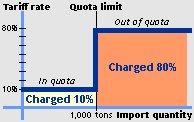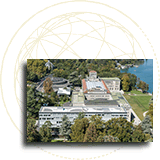UNDERSTANDING THE WTO:
THE AGREEMENTS
Agriculture: fairer markets for farmers
The original GATT did apply to agricultural trade, but it contained loopholes. For example, it allowed countries to use some non-tariff measures such as import quotas, and to subsidize. Agricultural trade became highly distorted, especially with the use of export subsidies which would not normally have been allowed for industrial products. The Uruguay Round produced the first multilateral agreement dedicated to the sector. It was a significant first step towards order, fair competition and a less distorted sector. It was implemented over a six year period (and is still being implemented by developing countries under their 10-year period), that began in 1995. The Uruguay Round agreement included a commitment to continue the reform through new negotiations. These were launched in 2000, as required by the Agriculture Agreement.
> See also: Doha Agenda negotiations
The
Agriculture Agreement: new rules and commitments
The objective of the Agriculture Agreement is to reform trade in the sector and to make policies more market-oriented. This would improve predictability and security for importing and exporting countries alike.
The new rules and commitments apply to:
- market access — various trade restrictions confronting imports
- domestic support — subsidies and other programmes, including those that raise or guarantee farmgate prices and farmers’ incomes
- export subsidies and other methods used to make exports artificially competitive.
The agreement does allow governments to support their rural economies, but preferably through policies that cause less distortion to trade. It also allows some flexibility in the way commitments are implemented. Developing countries do not have to cut their subsidies or lower their tariffs as much as developed countries, and they are given extra time to complete their obligations. Least-developed countries don’t have to do this at all. Special provisions deal with the interests of countries that rely on imports for their food supplies, and the concerns of least-developed economies.
“Peace” provisions within the agreement aim to reduce the likelihood of disputes or challenges on agricultural subsidies over a period of nine years, until the end of 2003.
back to top
Market access: ‘tariffs only’, please
The new rule for market access in agricultural products is “tariffs only”. Before the Uruguay Round, some agricultural imports were restricted by quotas and other non-tariff measures. These have been replaced by tariffs that provide more-or-less equivalent levels of protection — if the previous policy meant domestic prices were 75% higher than world prices, then the new tariff could be around 75%. (Converting the quotas and other types of measures to tariffs in this way was called “tariffication”.)
| Numerical targets for agriculture back to top The reductions in agricultural subsidies
and protection agreed in the Uruguay Round. Only the figures
for cutting export subsidies appear in the agreement.
The base level for tariff cuts was the bound rate before 1 January 1995; or, for unbound tariffs, the actual rate charged in September 1986 when the Uruguay Round began. The other figures were targets used to calculate countries’ legally-binding “schedules” of commitments. |
The tariffication package contained more. It ensured that quantities imported before the agreement took effect could continue to be imported, and it guaranteed that some new quantities were charged duty rates that were not prohibitive. This was achieved by a system of “tariff-quotas” — lower tariff rates for specified quantities, higher (sometimes much higher) rates for quantities that exceed the quota.
The newly committed tariffs and tariff quotas, covering all agricultural products, took effect in 1995. Uruguay Round participants agreed that developed countries would cut the tariffs (the higher out-of-quota rates in the case of tariff-quotas) by an average of 36%, in equal steps over six years. Developing countries would make 24% cuts over 10 years. Several developing countries also used the option of offering ceiling tariff rates in cases where duties were not “bound” (i.e. committed under GATT or WTO regulations) before the Uruguay Round. Least-developed countries do not have to cut their tariffs. (These figures do not actually appear in the Agriculture Agreement. Participants used them to prepare their schedules — i.e. lists of commitments. It is the commitments listed in the schedules that are legally binding.)
For products whose non-tariff restrictions have been converted to tariffs, governments are allowed to take special emergency actions (“special safeguards”) in order to prevent swiftly falling prices or surges in imports from hurting their farmers. But the agreement specifies when and how those emergency actions can be introduced (for example, they cannot be used on imports within a tariff-quota).
Four countries used “special treatment” provisions to restrict imports of particularly sensitive products (mainly rice) during the implementation period (to 2000 for developed countries, to 2004 for developing nations), but subject to strictly defined conditions, including minimum access for overseas suppliers. The four were: Japan, Rep. of Korea, and the Philippines for rice; and Israel for sheepmeat, wholemilk powder and certain cheeses. Japan and Israel have now given up this right, but Rep. of Korea and the Philippines have extended their special treatment for rice. A new member, Chinese Taipei, gave special treatment to rice in its first year of membership, 2002.
back to top
Domestic support: some you can, some you can’t
The main complaint about policies which support domestic prices, or subsidize production in some other way, is that they encourage over-production. This squeezes out imports or leads to export subsidies and low-priced dumping on world markets. The Agriculture Agreement distinguishes between support programmes that stimulate production directly, and those that are considered to have no direct effect.
Domestic policies that do have a direct effect on production and trade have to be cut back. WTO members calculated how much support of this kind they were providing per year for the agricultural sector (using calculations known as “total aggregate measurement of support” or “Total AMS”) in the base years of 1986-88. Developed countries agreed to reduce these figures by 20% over six years starting in 1995. Developing countries agreed to make 13% cuts over 10 years. Least-developed countries do not need to make any cuts. (This category of domestic support is sometimes called the “amber box”, a reference to the amber colour of traffic lights, which means “slow down”.)
Measures with minimal impact on trade can be used freely — they are in a “green box” (“green” as in traffic lights). They include government services such as research, disease control, infrastructure and food security. They also include payments made directly to farmers that do not stimulate production, such as certain forms of direct income support, assistance to help farmers restructure agriculture, and direct payments under environmental and regional assistance programmes.
Also permitted, are certain direct payments to farmers where the farmers are required to limit production (sometimes called “blue box” measures), certain government assistance programmes to encourage agricultural and rural development in developing countries, and other support on a small scale (“de minimis”) when compared with the total value of the product or products supported (5% or less in the case of developed countries and 10% or less for developing countries).
back to top
Export subsidies: limits on spending and quantities
The Agriculture Agreement prohibits export subsidies on agricultural products unless the subsidies are specified in a member’s lists of commitments. Where they are listed, the agreement requires WTO members to cut both the amount of money they spend on export subsidies and the quantities of exports that receive subsidies. Taking averages for 1986-90 as the base level, developed countries agreed to cut the value of export subsidies by 36% over the six years starting in 1995 (24% over 10 years for developing countries). Developed countries also agreed to reduce the quantities of subsidized exports by 21% over the six years (14% over 10 years for developing countries). Least-developed countries do not need to make any cuts.
During the six-year implementation period, developing countries are allowed under certain conditions to use subsidies to reduce the costs of marketing and transporting exports.
back to top
The least-developed and those depending on food imports
Under the Agriculture Agreement, WTO members have to reduce their subsidized exports. But some importing countries depend on supplies of cheap, subsidized food from the major industrialized nations. They include some of the poorest countries, and although their farming sectors might receive a boost from higher prices caused by reduced export subsidies, they might need temporary assistance to make the necessary adjustments to deal with higher priced imports, and eventually to export. A special ministerial decision sets out objectives, and certain measures, for the provision of food aid and aid for agricultural development. It also refers to the possibility of assistance from the International Monetary Fund and the World Bank to finance commercial food imports.
Share
What is this agreement called?
Most provisions: Agreement on Agriculture.
Commitments on tariffs, tariff quotas, domestic supports, export subsidies: in schedules annexed to the Marrakesh Protocol to the General Agreement on Tariffs and Trade 1994.
Also: [Ministerial] Decision on Measures Concerning the Possible Negative Effects of the Reform Programme on Least-Developed and Net Food-Importing Developing Countries.
(See also: “Modalities for the establishment of specific binding commitments under the reform programme”, MTN.GNG/MA/W/24, 21 pages: Word (126KB) or pdf (89KB).)
This a key issue. Trade is distorted if prices are higher or lower than normal, and if quantities produced, bought, and sold are also higher or lower than normal — i.e. than the levels that would usually exist in a competitive market.
For example, import barriers and domestic subsidies can make crops more expensive on a country’s internal market. The higher prices can encourage over-production. If the surplus is to be sold on world markets, where prices are lower, then export subsidies are needed. As a result, the subsidizing countries can be producing and exporting considerably more than they normally would.
Governments usually give three reasons for supporting and protecting their farmers, even if this distorts agricultural trade:
![]() to make sure that enough food is produced to meet the country’s
needs
to make sure that enough food is produced to meet the country’s
needs
![]() to shield farmers from the effects of the weather and swings
in world prices
to shield farmers from the effects of the weather and swings
in world prices
![]() to preserve rural society.
to preserve rural society.
But the policies have often been expensive, and they have created gluts leading to export subsidy wars. Countries with less money for subsidies have suffered. The debate in the negotiations is whether these objectives can be met without distorting trade.
This is what a tariff-quota might look like

Imports entering under the tariff-quota (up to 1,000 tons) are generally charged 10%. Imports entering outside the tariff-quota are charged 80%. Under the Uruguay Round agreement, the 1,000 tons would be based on actual imports in the base period or an agreed “minimum access” formula.
Tariff quotas are also called “tariff-rate quotas”.
